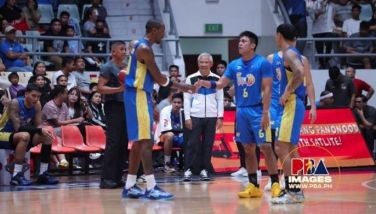Regaining the glory of Manila Bay
September 26, 2004 | 12:00am
At the heart of the country’s capital city lies an age-old natural legacy that is reflective of the Filipino soul – the Manila Bay. A semi-closed estuary, it hosts a diverse range of fisheries, aquaculture, agricultural and mineral resources, forests and urban ecosystems, and boasts of rich cultural, recreation, historical and tourism values. The Bay also serves as a vital engine of economic growth of the country, especially in Region 3 (Central Luzon), Region 4 (Southern Tagalog), and National Capital Region (NCR). Its location also enables the country to easily gain access to transboundary development with neighboring Asian countries.
For the past two to three decades, however, this heart-shape Bay has been a repository of all kinds of debris/wastes from various sources like households, institutions, agriculture and industries. Findings from a study conducted by the Manila Bay Environmental Management Project (MBEMP) of the Department of Environment and Natural Resources (DENR) titled "Manila Bay Refined Risk Assessment" launched in March 2004, confirms the bay’s status of being a "pollution hotspot". To address this critical situation, this same study also recommends a coordinated and unified effort among the government, local government units, private sector. Non-Government Organizations, civil society, and the households so that the grandeur-that-was of the historic Manila Bay can once again, be regained.
On Sept. 18, the DENR led by Secretary Michael T. Defensor, spearheaded a coastal clean-up activity along Manila Bay in observance of the 10th International Coastal Clean-Up. Defensor firmly believes that Filipinos must "clean up to move up . . . as our collective effort in preserving one of our country’s greatest legacy and resource – the Manila Bay – greatly contributes to nation-building and economic development." Thousands joined the DENR in giving a fresh look of the Bay composed of volunteers from public and private schools, industries, government agencies, non-government organizations and institutions, and civil society. The cleaning up was undertaken along US Embassy Baywalk, Roxas Boulevard, fisherman’s wharf and Public Estates Authority (PEA). The MBEMP-DENR plays a big role in this activity.
The MBEMP based in the DENR, is one of the three (3) sub regional projects under the regional program on building Partnerships in Environment for Seas of the East Asia (PEMSEA) being supported by the United Nations Development Program/Global Environmental Facility fund. (The other sites are Bohai Sea (China) and the Gulf of Thailand). PEMSEA seeks to address transboundary environmental issues, develop a strategic Environmental
Management Plan, and employ integrated coastal management to address local environmental issues in the Bay area. Different sectors and institutions and local governments along the coast of Manila Bay have been exerting collaborative efforts in the implementation of the project towards the project’s vision of Manila Bay with clean, safe, wholesome and productive ecosystem, center of socio-economic development and with enhanced quality of life for the present and future generations.
For the past two to three decades, however, this heart-shape Bay has been a repository of all kinds of debris/wastes from various sources like households, institutions, agriculture and industries. Findings from a study conducted by the Manila Bay Environmental Management Project (MBEMP) of the Department of Environment and Natural Resources (DENR) titled "Manila Bay Refined Risk Assessment" launched in March 2004, confirms the bay’s status of being a "pollution hotspot". To address this critical situation, this same study also recommends a coordinated and unified effort among the government, local government units, private sector. Non-Government Organizations, civil society, and the households so that the grandeur-that-was of the historic Manila Bay can once again, be regained.
On Sept. 18, the DENR led by Secretary Michael T. Defensor, spearheaded a coastal clean-up activity along Manila Bay in observance of the 10th International Coastal Clean-Up. Defensor firmly believes that Filipinos must "clean up to move up . . . as our collective effort in preserving one of our country’s greatest legacy and resource – the Manila Bay – greatly contributes to nation-building and economic development." Thousands joined the DENR in giving a fresh look of the Bay composed of volunteers from public and private schools, industries, government agencies, non-government organizations and institutions, and civil society. The cleaning up was undertaken along US Embassy Baywalk, Roxas Boulevard, fisherman’s wharf and Public Estates Authority (PEA). The MBEMP-DENR plays a big role in this activity.
The MBEMP based in the DENR, is one of the three (3) sub regional projects under the regional program on building Partnerships in Environment for Seas of the East Asia (PEMSEA) being supported by the United Nations Development Program/Global Environmental Facility fund. (The other sites are Bohai Sea (China) and the Gulf of Thailand). PEMSEA seeks to address transboundary environmental issues, develop a strategic Environmental
Management Plan, and employ integrated coastal management to address local environmental issues in the Bay area. Different sectors and institutions and local governments along the coast of Manila Bay have been exerting collaborative efforts in the implementation of the project towards the project’s vision of Manila Bay with clean, safe, wholesome and productive ecosystem, center of socio-economic development and with enhanced quality of life for the present and future generations.
BrandSpace Articles
<
>
- Latest
Latest
Latest
May 14, 2024 - 3:43pm
By Ian Laqui | May 14, 2024 - 3:43pm
April 10, 2024 - 5:12pm
By Ian Laqui | April 10, 2024 - 5:12pm
March 4, 2024 - 3:32pm
By Ian Laqui | March 4, 2024 - 3:32pm
March 4, 2024 - 2:12pm
By Kristine Daguno-Bersamina | March 4, 2024 - 2:12pm
February 17, 2024 - 2:31pm
February 17, 2024 - 2:31pm
Recommended




























